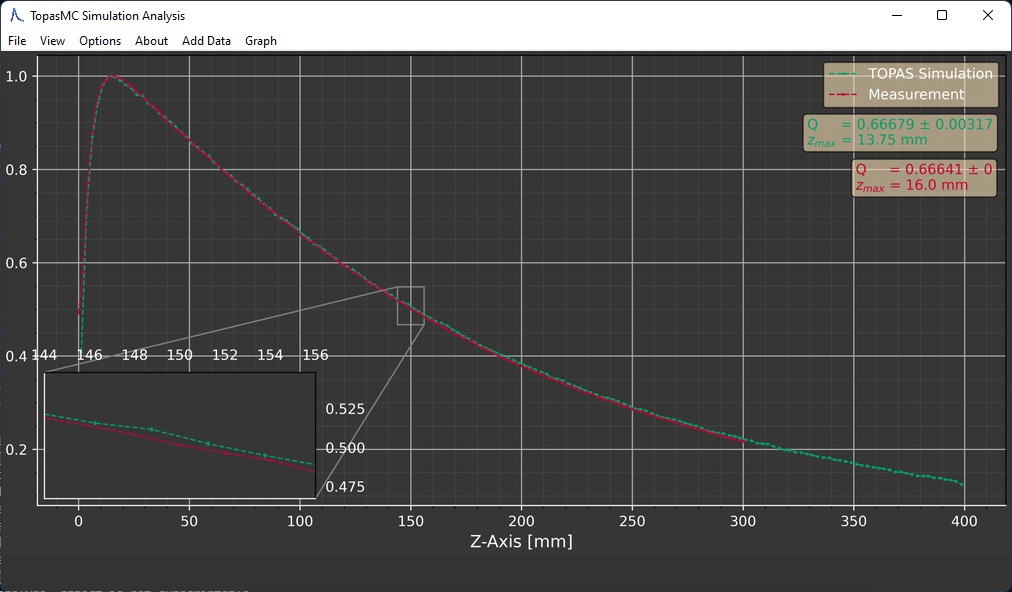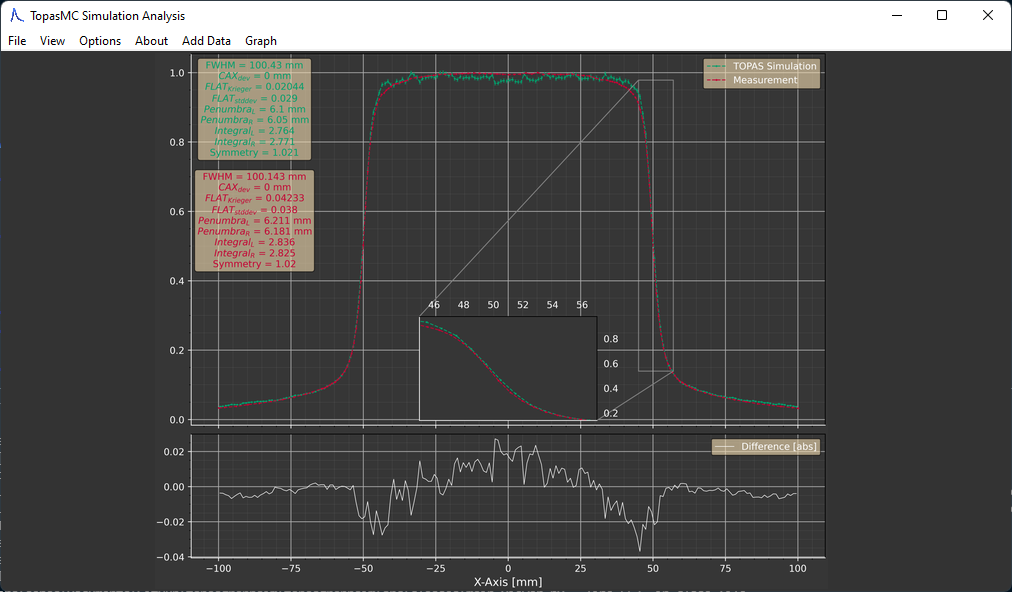GUI to analyze the results of a Monte-Carlo radiation simulation
Project description
TopasGraphSim
A GUI to simplify and streamline the plotting and analysis of medical physics simulations

This GUI can visualize and analyze percentage depth dose (pdd) and dose profiles (dp) simulations from TOPAS. Depth dose measurements are assumed to be in the z-direction, dose profiles in the x- or y-directions. Data read-in is handled by topas2numpy.
Installation
Install using pip:
$ pip install topasgraphsim
Then, start the GUI by running:
$ python -m topasgraphsim
Or, if your Python is added to $PATH, simply run:
$ topasgraphsim
Open compatible files from the command line:
$ topasgraphsim "path_to_your_file"
Note: Linux users need to have python3-tk installed. If it isnt installed yet, use:
$ sudo apt-get install python3-tk
Also, you may need python-dev. Install if for your python version using:
$ sudo apt-get install python<your main version>-dev
Since all my testing in done on Windows 11, I cannot guarantee this will work on any other plattform. I'm open to suggestions or PRs making the software work better cross-plattfrom!
Features
- Reproducible graphing and analysis of 1D TOPAS simulation for medical physics
- Simultaneous plotting and parameter calculation for up to 10 datasets
- Calculation of the Gamma Index
- Graph adjustment options
- Normalization (On/Off)
- Error bars (On/Off)
- Difference plot between two datasets
- Graph order and colors
- Marker size and style
- Line width
- Zoom-in window
- Half view of dose profiles
- Drag and drop of files
- Value indication on hover
- Center axis deviation correction
- Import of EGS and RadCalc simulation results
- Import of custom measurements (as numpy .txt files)
- Import of PTW tbaScan (MEPHYSTO mc2) measurements
- Easy to use keyboard shortcuts (see manual below)
- German and english language support
- Dark mode
Screenshots
Manual
Most customization options are available via the menubar, however the workflow can be sped up greatly by using the included keyboard and mouse shortcuts documented below.
Loading and saving data
| Keyboard Shortcut | Associated Function |
|---|---|
| Ctrl + O | Open a TOPAS simulation file [*.csv *.bin] |
| Ctrl + P | Open a PTW tbaScan file [*.mcc] |
| Ctrl + T | Open a PDD measurement file [*.txt] |
| Ctrl + D | Open a DP measurement file [*.txt] |
| Ctrl + S | Save the current graph [*.png *.jpg] |
| Ctrl + Z | Remove the last imported dataset |
| Escape | Close the current project |
Adjusting the Graph Style
| Mouse/Keyboard Shortcut | Associated Function |
|---|---|
| Ctrl + ↑ ↓ | Increase/decrease the marker size |
| Ctrl + ← → | Increase/decrease the line width |
| Scrollwheel | Increase/decrease the X-axis limits |
| Ctrl + Alt + + - | Increase/decrease the error plot upper limits |
| Ctrl + Shift + + - | Increase/decrease the error plot lower limits |
| Double Left Click on Graph | Change zoom window location |
| Left Click on Top of Graph | Add/change title |
| Left Click on Left Axis | Rename left axis |
| Left Click on Bottom Axis | Open axis range selector |
| Left Click on Bottom Axis | Rename bottom axis |
Adjusting the Graph Legend
| Mouse/Keyboard Shortcut | Associated Function |
|---|---|
| Hover over Graph Name + ↑ ↓ | Change the graph order |
| Left Click on Graph Name | Rename the selected graph |
| Right Click on Graph Name | Change color of the selected graph |
Parameters
Depending on the imported measurement, the following parameters can be calculated:
| Measurement type | Parameters | |||||
|---|---|---|---|---|---|---|
| Depth dose | Q-Factor | zmax | ||||
| Dose profile | FWHM | CAXdev | FLATKrieger | FLATstddev | Penumbra (L&R) | Integral (L&R) |
-
Q-Factor : Radiation Quality Factor
-
zmax : Depth at Maximum
-
FWHM : Full-Width at Half-Maximum
-
CAXdev : Centre Axis Deviation
-
FLATKrieger : Flatness of Dose Plateau (Definition by Krieger)
-
FLATstddev : Flatness of Dose Plateau (Standard Deviation)
-
Penumbra (L&R) : Width of Left and Right Penumbra
-
Integral (L&R) : Integral below Left and Right Penumbra
Dependencies
Built using the beautiful Azure-ttk theme by @rdbende. Requires python3, numpy, scipy, matplotlib, Pillow, python-opencv, pynput, requests, topas2numpy and tkinter.
The drag-and-drop functionality is powered by TkinterDnD2 by Michael Lange and tkdnd by @petassis.
Contact me!
Thank you for using TopasGraphSim! Please let me know about any issues you encounter, or suggestions/wishes you might have!
Project details
Release history Release notifications | RSS feed
Download files
Download the file for your platform. If you're not sure which to choose, learn more about installing packages.
Source Distribution
Built Distribution
Hashes for topasgraphsim-22.0.0-py3-none-any.whl
| Algorithm | Hash digest | |
|---|---|---|
| SHA256 | 4490e5d751fa0a24a3c3248a85b56da0150b6aa8b994fb9dc658d0845630d34f |
|
| MD5 | f8536dabe11756844f31f5f10fa7bc92 |
|
| BLAKE2b-256 | d1b49ae7ffe75a112eb5987651440c3f7d543910606cd9c44b690f16bd51ef34 |














